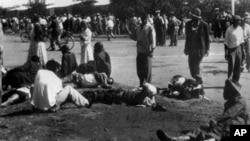This weekend South Africans will mark the 50th anniversary of the Sharpeville Massacre in which 69 people were killed and hundreds more were injured by police in an incident that marked a turning point in the country's history.
It was a day that, like the bullets that flew across the dusty streets of the impoverished township of Sharpeville, would soon reverberate across South Africa and across the globe.
Soon after 1:00 pm, on a warm autumn afternoon police fired without warning on a crowd of about 5,000 peaceful protesters who had converged on the Sharpeville police station to burn their so-called apartheid era pass-books and offer themselves for arrest. Most of the 69 people killed, and 180 injured, were shot in the back as they attempted to flee.
Ahmed Dangor, CEO of the Nelson Mandela Foundation, tells VOA the massacre set in motion what many now see as an inevitable chain of events.
"And in a sense what it did was put in motion the slow chain of events that ultimately led to the South African government yielding to local and international pressure and un-banning the liberation movements and un-banning Nelson Mandela in 1990," he said.
The protesters in Sharpeville, like thousands more in several other black townships across the country, were protesting against the hated "dompas' or pass-book which black South Africans were compelled to carry at all times. Dangor explains the pass-book was so much more than simply a document of identification.
"But think about 1960, here blacks were burning the very document that in a sense was their passport to life. You couldn't get work without a pass [identification document that identified people by race, and where they were able to live and work]; you couldn't travel without a pass, and yet people were brave enough to burn it," he said.
The protests on March 21st, 1960 were organized by the Pan Africanist Congress, PAC, which led by Robert Sobukwe, had broken away from the African National Congress, ANC, the previous year.
In his autobiography, Long Walk to Freedom, former President Nelson Mandela writes that the ANC had already announced plans for a series of protests starting March 31, but was pre-empted by the PAC plans.
The events on March 21 precipitated a crackdown on the liberation movements and individuals by the apartheid state led at the time by the National Party's Hendrik Verwoerd. As Prime Minister, Mr. Verwoerd had introduced numerous laws to establish the raced-based discriminatory system known as apartheid - earning him the title, architect of apartheid.
By 1964 many of the leaders of the liberation movements were in jail or in exile. But Dangor says that while the post-Sharpeville crackdown may have prolonged the struggle against apartheid, it also shook the government.
"But in a sense what it also did was undermine the, both the reality and the perception of this monolith, this concrete monolith that was unmovable. They were shaken enough to respond as violently as they did," he said.
On December 10 1996, Mr Mandela chose Sharpeville to sign into force South Africa's internationally acclaimed constitution, which includes a Bill of Rights and other clauses to guarantee human rights. Pregs Govender, Deputy National Commissioner of the South African Human Rights Commission, tell VOA many of the protections enshrined in the founding law can be traced back to how people responded to the Sharpeville massacre.
"So I think the sense of commitment to say never again was a very, very strong one and motivated the people who fought within the liberation movements across the country, and who participated in the negotiations and in the drafting of the constitution," he said.
In 1994, Mr. Mandela's newly elected government designated March 21 as Human Rights Day, a national holiday in South Africa.





